Emission Systems - Transmission Controlled Spark Combined Emission Control (CEC) 1971
Construction and Operations
The 1971 TCS system differs from the 1970 TCS system. The 1970 TCS system was altered to meet the more stringent emission control requirements for 1971 by adding, deleting, or changing electrical and mechanical control devices. (Fig 71.1). The system was renamed "Combined Emission Control" (CEC).
The primary purpose is to reduce exhaust emissions by eliminating distributor advance in low forward gears remained the same as the 1970 model year. Changes for 1971 include:
![]() A completely new vacuum advance (CEC) solenoid.
A completely new vacuum advance (CEC) solenoid.
![]() Two completely new relays: A 20-second time delay relay and a reversing
relay.
Two completely new relays: A 20-second time delay relay and a reversing
relay.
![]() Elimination of the 1970 type relay.
Elimination of the 1970 type relay.
![]() Elimination of the idle stop relay.
Elimination of the idle stop relay.
![]() Recalibration of the temperature override switch, up to 82° F from
63".
Recalibration of the temperature override switch, up to 82° F from
63".
![]() Click here for further information on the CEC
Solenoid, Cold Override Temperature Switch, Time-Delay Relay, Reversing
Relay, Transmission Switch, and Troubleshooting
Click here for further information on the CEC
Solenoid, Cold Override Temperature Switch, Time-Delay Relay, Reversing
Relay, Transmission Switch, and Troubleshooting
![]() Test Procedures
Test Procedures
![]() Anti-Dieseling Devices on Air Conditioned Vehicles
Anti-Dieseling Devices on Air Conditioned Vehicles
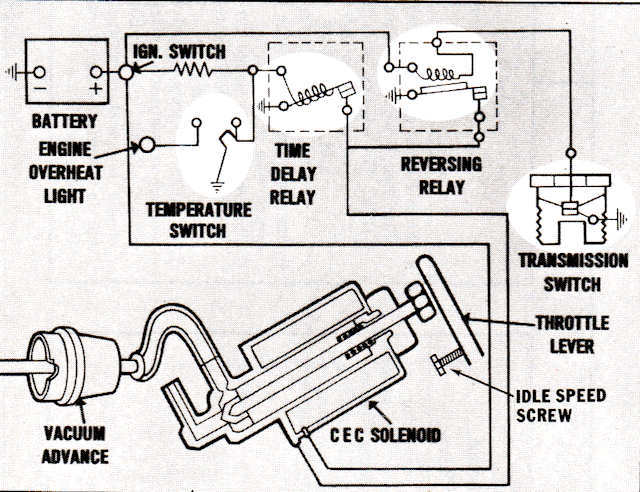
Fig 71.1 - 1971 CEC System - Engine Off
The CEC solenoid is controlled by the temperature switch, transmission switch and time-delay relay. The CEC solenoid allows vacuum to the advance unit when energized and denies vacuum when de-energized. CEC valve operation is just the opposite of the 1970 vacuum advance solenoid operation.
Due to the changes in the CEC valve, a reversing relay was designed for the system. The reversing relay reverses the function of the transmission switch. When the transmission switch points open (in high gear) the reversing relay points close and provide a path to ground energizing the CEC solenoid. When the transmission switch points close, the reversing relay points open, the reversing relay points open breaking the circuit and de-energizing the CEC solenoid.
"Cold" override is provided by the engine temperature switch, regardless of gear position, when coolant temperature is below 82° F. When the engine temperature reaches 82° F, the temperature switch opens. This energizes the circuit to the time-delay relay, allowing the additional 15-20 seconds of full vacuum advance to the distributor. If the engine is within the normal operating temperature range at initial start-up, the cold override switch is by-passed, and control of the vacuum advance for start and drive-away is provided by the time-delay relay. Certain models also incorporate a "Hot" override feature. If the coolant temperature exceeds 232° F, the hot override circuit energizes the CEC valve and allows vacuum to the advance unit to aid in cooling the engine temperature.
Control of engine dieseling tendencies is achieved by lower throttle blade openings resulting from lower curb idle speeds. To prevent dieseling on air conditioned vehicles with an automatic transmission, which is caused by the larger throttle angle required when setting ideal with the air conditioning on, a solid state time device located under the dash allows the air conditioning compressor clutch to become engaged for approximately three seconds after the ignition is turned off. The additional load the compressor places on the engine brings it to a top sooner effectively reducing the tendency to diesel.
Each component plays an important part in the total system operation and should be maintained so it functions at maximum performance at all times.
Looking at the CEC wiring diagram (Fig 71.1), you'll see that with the ignition off, all components are at rest. The temperature switch points are closed to the cold contact, the time-delay relay points are closed, the reversing relay points are closed, the transmission switch points are closed, and the CEC solenoid is de-energized.
When the ignition switch is turned on, with coolant temperatures below 82° F, a circuit is formed from the battery to the CEC solenoid and grounded through the time delay-relay (Fig 71.1). This energizes the CEC solenoid causing the plunger to extend, contacting the throttle lever to provide deceleration control at a preset valve. This also opens the vacuum port to the distributor advance unit. The transmission switch points are closed (transmission in other than high gear), and the reversing relay points are held open. The time-delay points remained closed as long as the temperature switch is closed to ground, because current is following the path of the least resistance. With the temperature switch grounded, current to the time-delay relay is not sufficient to heat the coils and open the points.
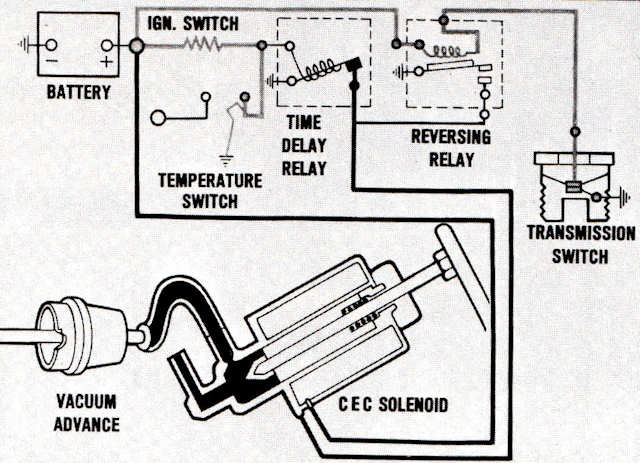
Fig 71.2 - 1971 CEC System (Cold Override Energized)
When the engine coolant temperature goes above 82° F, the temperature switch points open. The circuit from the battery to time-delay relay is then completed, but the time-delay points will remain closed for approximately 20 seconds until the coil heats sufficiently. This provides vacuum advance for cold drive-away performance. the transmission is still in other than high gear, and therefore the transmission switch points are closed with the reversing relay points still open (Fig 71.3).
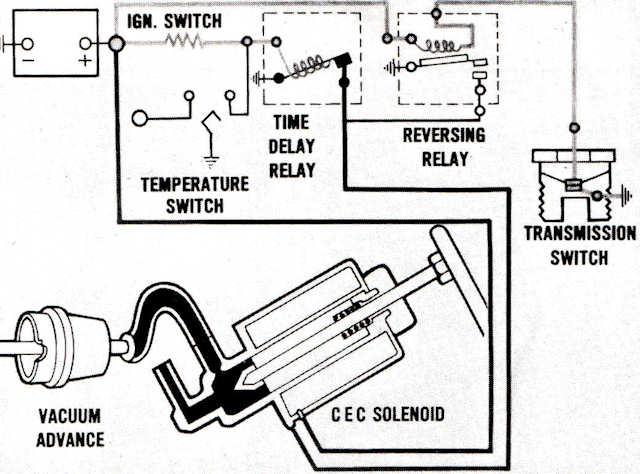
Fig 71.3 - Solenoid Activated By Time-Delay Switch
The time-delay relay coil heats up during the 20-second event and points open. This then breaks the circuit to the CEC solenoid, de-energizing it and cutting off vacuum supply to the distributor advance unit (Fig 71.4).

Fig 71.4 - System Normalized and Transmission in Low Gear
If the ignition were turned off after the engine coolant temperature rose to above 82° F, the time-delay relay coil would cool and the points would close. Upon restarting the engine, the relay would complete the solenoid circuit to ground, energizing the solenoid.
When the transmission shifts into high gear, the transmission switch points open by either shift action or oil pressure. This breaks the circuit through the reversing relay which causes the reversing relay points to close, which completes the solenoid circuit to ground. This energizes the solenoid which allows vacuum to the distributor advance unit (Fig 71.5). Vacuum will be allowed to the distributor as long as the transmission is in high gear.
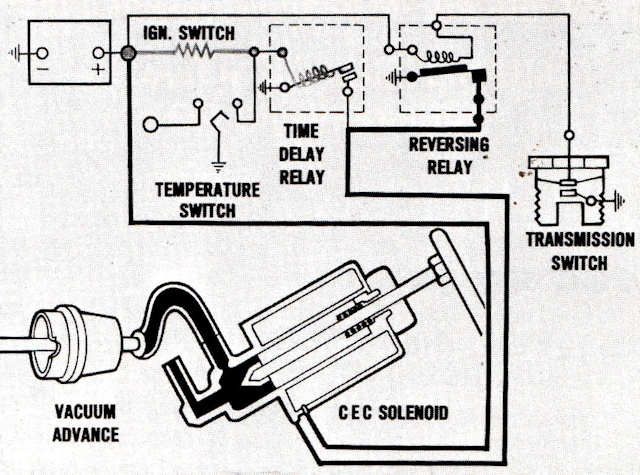
Fig 71.5 - System Normalized and Transmission in High Gear
Some engines feature a "hot" override provision. This is used on all Corvettes equipped with either the 350-cid or 454-cid engines, automatic transmission and air conditioning, as well as Camaro's with the 402-cid engine, automatic transmission and air conditioning.
The "hot" override contact is tied into the overheat light circuit on these applications (Fig 71.6). When the engine temperature reaches 230" F, the "hot" override temperature switch points close. this complete a circuit from the battery through the path of least resistance to ground. With the current bypassing the e time-delay relay, the coil cools which permits the time-delay relay points to close. With these points closed, another circuit is completed through the CEC solenoid and the time-delay relay to ground. This energizes the solenoid and provides vacuum to the distributor advance unit. When the engine temperature reaches 257" F, the engine overheat temperature switch points close. This complete a circuit to and activates the warning light located in the instrument cluster.
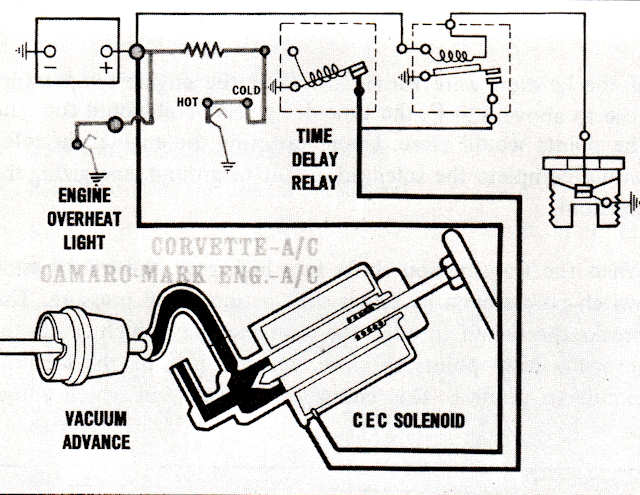
Fig 71.6 - Solenoid Energized By Hot Override Circuit
![]() Mention you saw it on © ChevelleWorld and please give the site credit for the
information.
Mention you saw it on © ChevelleWorld and please give the site credit for the
information.
![]() Be sure to visit my ChevelleCD site for
Chevelle CDs, challenge coins, and other gifts for that Chevelle fan in your
family and my
Stickers & Calendars website for custom stickers and calendars with your
favorite car/pet/occasion.
Be sure to visit my ChevelleCD site for
Chevelle CDs, challenge coins, and other gifts for that Chevelle fan in your
family and my
Stickers & Calendars website for custom stickers and calendars with your
favorite car/pet/occasion.
Say you saw it here on © ChevelleWorld
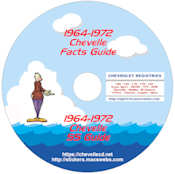
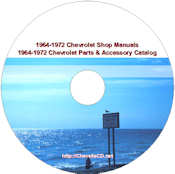


Want more in-depth information on 1964-1972 Chevelles? My Facts and SS Guide
program CD, my Shop Manuals & Parts Catalog program DVD, and my 1964-1972
Trim Tag, Warranty Card program CD and my Chevy Numbers program
CD. Check them and other informative
program CDs at my https://chevellecd.net
website.
© ChevelleWorld

 1964 Chevelle
1964 Chevelle 1965 Chevelle
1965 Chevelle 1966 Chevelle
1966 Chevelle 1967 Chevelle
1967 Chevelle 1968 Chevelle
1968 Chevelle 1969 Chevelle
1969 Chevelle 1970 Chevelle
1970 Chevelle 1971 Chevelle
1971 Chevelle 1972 Chevelle
1972 Chevelle


